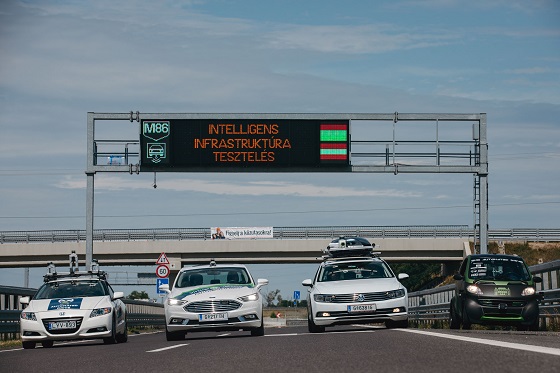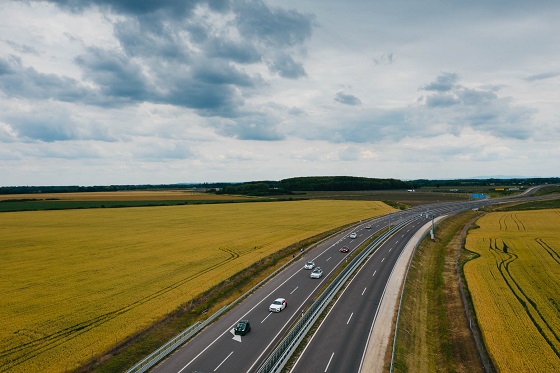Intelligent transportation infrastructure development

The project,Development of Central System Architecture for Autonomous Vehicle Testing and Operation of Related Services, supported by both the Hungarian and the Austrian goverment, aims to provide an incubation test environment for local and international automotive industry players. The development of a sensor-rich public road section, as part of the project, offers a unique opportunity for the advancement of intelligent infrastructures and partially, or fully autonomous vehicles worldwide.
The first milestone of the project is a multi-day measurement series, during which researchers will test the benefits of cooperative environmental sensors using specially equipped cars and trucks on a closed section of the intelligent road, supported by 5G data communication technology.
Intelligent infrastructures play a key role in the spread of self-driving vehicles. Without them it is difficult to achieve mixed vehicle traffic with human and robotic drivers. Roads with sensors will be able to send raw and processed data to vehicles, increasing detection capability by several kilometers, opening the opportunities for many new services.
AI-based central data processing can transmit suggestions and alerts to human or robotic drivers to avoid congestion and accidents. Advanced infrastructures could serve as a communication platform for vehicles, enabling them to interact with each other. A braking or accelerating car could warn those around it, and predictive systems could anticipate or even automatically eliminate dangerous situations.

The deployment of smart infrastructures is currently set back by a number of technology, standardization and service models that are under development. One of the biggest challenges is meeting the extremely strict security standards for communication. The technology needs to allow for nearly real-time communication in all weather conditions, and the data cannot be tampered with by an external party.
5G telecommunication technology is ideal for this, providing bandwidth and virtually delay-free data traffic, which is imperative for a mass of high-speed self-driving vehicles to make reliable and safe driving decisions based on data from external sources.
The current project is significant, not only because it is implemented in cooperation with local and international actors in all industries invested in the development of smart infrastructures and autonomous technologies, but also because creating a measurement environment on a public road, supported by 5G technology has never been seen before. This new innovation platform can increase the region’s attractiveness for advanced automotive industry investments as well as provide a significant competitive advantage for local research and development activities.
Statements
“Numerous cameras, sensors and signaling equipment are already in use along the Hungarian roads, but the development of telecommunication and IT opens up new prospects in traffic regulation and data transfer. As road managers, we need to be prepared and ready to adapt in order to keep up with the developments of car manufacturers. With this measurement project and the subsequent laboratory evaluation, we will get closer to understanding and implementing the latest technologies. Moreover, this vehicle and infrastructure communication technology will open a new information channel for drivers and passengers alike. The information coming from the vehicles, that are practically moving sensors, will be highly useful for traffic management, detection of congestion and traffic slowdown. We trust in the success of the project. The engineering team of Csorna and our R&D experts and engineers will do everything to provide the right environment for it." -Attila József Szilvai, CEO, Hungarian Public Road Nonprofit Pte Ltd Co.
"The big problem with transportation is the well-known shortage of drivers. Drivers are overworked and they carry an enormous responsibility on their shoulders. By automating certain functions of commercial vehicles we ease their workload and improve transport safety and efficiency. " -Péter Frank, R&D Director, Knorr-Bremse
“With the spread of 5G networks, by 2030 the automotive industry could be one of the industries profiting greatly from the benefits of next-generation networks, thus providing new sources of revenue for mobile operators. According to our forecasts, by 2025 most new cars placed on the market will be able to communicate with other vehicles on the roads, as well as with the infrastructure.” -Gábor Éry, CEO of Ericsson Hungary
“Autonomous driving is a great example of how the emergence of 5G makes our lives better, more comfortable and safer, which is why we have been supporting this important local innovation project from the very beginning. 5G as a driving force for digitalization will soon emerge in other areas of production and services: automotive industry, agriculture, healthcare, education, transportation and power. 5G opens up completely new perspectives everywhere and raises economic development and competitiveness to a higher level. That is why we find it crucial to provide the best possible network background for the use of digital technologies and to actively support local innovation.” -Tibor Rékasi, CEO of Magyar Telekom
“The greatest significance of this project is bringing together stakeholders involved in the development and operation of self-driving vehicles and intelligent infrastructures. Public road operators (Hungarian Public Road Nonprofit Pte Ltd Co. and Budapest Közút Zrt.), by building futureproof intelligent infrastructures, telecommunication companies, by creating ultra-fast and high-bandwidth data transfer between vehicles and infrastructure (operations: Magyar Telekom, technology development: Ericsson), automotive industry players (Knorr -Bremse, ZalaZONE), by delivering complete self-driving systems and ensuring the environment for testing, and the academic institution (BME), by providing R&D expertise and coordination, work together to get closer to one of the biggest transportation challenges of the future: to lay the foundation for the safe use of autonomous vehicles on public roads." -Dr. Zsolt Szalay, BME, associate professor

